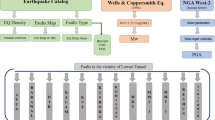Abstract
It is noted in the article that the increase in peak ground acceleration (PGA) by a factor of about 1.4 proposed by seismologists in a project of seismic intensity scale clearly reflects the lessons learned from earthquakes of the past. However, the use of suggested PGA values in the design codes and standards requires modification of the codes and standards themselves, as well as differentiated approach to defining the design level of PGA. Engineers should consider the dependence of the design PGA on the oscillation periods of structures, whereas seismologists should differentiate the PGA value depending on the prevailing period of the seismic effect. Transition to the new seismic scale affects the design and maximum design earthquakes differently. The intensity of a design earthquake for objects of massive structure does not exceed VII on the MSK scale, and in this aspect the new seismic scale does not differ considerably from the existing one. For maximum design earthquakes, PGA increases significantly, but the criterion of seismic resistance changes from acceleration of the structure to the work of plastic deformation forces. In this case, possible destruction depends little on PGA, but rather on such energy seismic effect characteristics as the Arias intensity, absolute cumulative velocity, and seismic energy density. A correct approach to calculation when carrying out the performance-based design and transition to the new intensity scale would not lead to higher costs for most buildings and structures. Moreover, if one does not use the new scale, transition to modern methods of performance-based design will be impossible.



Similar content being viewed by others
REFERENCES
Aptikaev, F.F., Instrumental’naya shkala seismicheskoi intensivnosti (Instrumental Scale of Seismic Intensity), Moscow: Nauka i obrazovanie, 2012.
Arias, A., A measure of earthquake intensity, in Seismic Design for Nuclear Power Plants, Hansen, R.J., Ed., Cambridge, Mass.: MIT Press, 1970, pp. 438–483.
Campbell, K.W. and Bozorgnia, Y., Cumulative absolute velocity (CAV) and seismic intensity based on the PEER-NGA Database, Earthquake Spectra, 2012, vol. 28, no. 2, pp. 457–485.
Chen, G.X., Evolution and prospect of seismic design code for buildings in China, J. Disaster Prev. Mitigation Eng., 2003, vol. 23, no. 1, pp. 102–113.
GB50011-2010 (China Building Code): Code for Seismic Design of Buildings, 2010.
Dolgaya, A.A., Modeling of seismic effect by a short temporal process, Ekspress-Inf. VNIINTPI. Ser. Seismostoik. Stroit., 1994, nos. 5–6, pp. 56–63.
Dolgaya, A.A. and Indeikin, A.V., Statistical analysis of Arias-based intensity and velocities for real earthquakes, Seismostoik. Stroit., 2002, no. 2, pp. 32–33.
Gol’denblat, I.I., Nikolaenko, N.A., Polyakov, S.V., and Ul’yanov, S.V., Modeli seismostoikosti sooruzhenii (Models of Earthquake Design for Structures), Moscow: Stroiizdat, 1979.
GOST (State Standard) 6249-52: Scale for Determining Earthquake Intensity in the Range from VI to IX, 1952.
Korchinskii, I.L. and Barshtein, M.F., Improving method for calculation of buildings and structures resistance to seismic effects, in Snizhenie stoimosti i uluchshenie kachestva seismostoikogo stroitel’stva (Decreasing Costs and Improving Quality of Earthquake-Resistant Buildings), Moscow: Stroiizdat, 1961, pp. 30–37.
Medvedev, S.V., International scale of seismic intensity, in Seismicheskoe raionirovanie SSSR (Seismic Zoning of the USSR), Moscow: Nauka, 1968, pp. 151–162.
Medvedev, S.V., Determination of earthquake intensity, Vopr. Inzh. Seismol., 1978, vol. 19, pp. 108–116.
Nemchinov, Yu.I., Marenkov, N.G., Khavkin, A.K., and Babik, K.N., Proektirovanie zdanii s zadannym urovnem obespecheniya seismostoikosti (s uchetom rekomendatsii EVROKODA 8, mezhdunarodnykh standartov i trebovanii DBN) (Design of Buildings with the Set Earthquake Resistance Level (with the EUROCODE 8 Recommendations, International Standards, and State Building Norms Being Taken into Consideration)), Kiev: Minregion Ukr., 2012.
Omori, F., Seismic experiments on the fracturing and overturning of columns, Publ. Earthquake Invest. Comm. Foreign Lang., 1900, no. 4, pp. 69–141.
RABC (Republic of Armenia Building Code) II-6.02-2006: Earthquake Resistant Construction Design Codes, 2006. European Macroseismic Scale EMS-98, Grűnthal, G., Ed., ESC, Luxemburg, 1998.
SEISMO-2016, Proceedings of the Eurasian Forum, Moscow, Russia, 2016. http://www.nopriz.ru/upload/ iblock/43a/programma-seminara-seysmo_2016-_red.-1_.pdf. Accessed October 1, 2018.
Shivua, A.D. and Rutman, Yu.L., Energy-based method for estimating earthquake resistance using specific energy density, in Aktual’nye problemy sovremennogo stroitel’stva: Sbornik dokladov 68-i Mezhdunarodnoi nauchno-prakticheskoi konferentsii studentov, aspirantov i molodykh uchenykh (Topical Problems of Contemporary Building Industry: Reports of the 68th International Research and Practical Conference for Students, Post-Graduate Students, and Young Scientists), St.-Peterb. Gos. Arkhit.-Stroit. Univ., 2015, vol. I, pp. 6–11.
SN (Building Code) 8-57: Code of Building in Regions Prone to Earthquakes, 1958.
SNiP (Building Code) II-A.12-69*: Building in Regions Prone to Earthquakes. Design Norms, 1977.
SNT (Building Code of Turkmenistan) 2.01.08-99*: Building in Regions Prone to Earthquakes. Section 1, 2009.
SP (Building Norms) 14.13330.2014. Building in Regions Prone to Earthquakes. Updated Version of SNiP II-7-81*, 2014.
Syuekhiro, K., Inzhenernaya seismologiya (Engineering Seismology), Moscow: Ekonomicheskaya zhizn’, 1935.
Zavriev, K.S., Nazarov, A.G., Aizenberg, Ya.M., Darbinyan, S.S., Kartsivadze, G.N., Rasskazovskii, V.T., Khachiyan, E.E., and Shaginyan, S.A., Osnovy teorii seismostoikosti zdanii i sooruzhenii (Fundamentals of Earthquake Design for Buildings and Structures), Zavriev, K.S., Ed., Moscow: Stroiizdat, 1970, vol. 2.
ACKNOWLEDGMENTS
The work was carried out in the framework of grant no. 16-58-53095 (entitled “Development of the Theory of Limit States for Providing Seismic Resistance of Railway Bridges under Structure and in Operation”) by the Russian Foundation for Basic Research.
Author information
Authors and Affiliations
Corresponding authors
Additional information
Translated by N. Astafiev
About this article
Cite this article
Nesterova, O.P., Tkachenko, A.S., Uzdin, A.M. et al. On Setting the Level of Seismic Effect in Seismic Intensity Scales and Design Standards. Seism. Instr. 55, 111–116 (2019). https://doi.org/10.3103/S0747923919010110
Published:
Issue Date:
DOI: https://doi.org/10.3103/S0747923919010110




